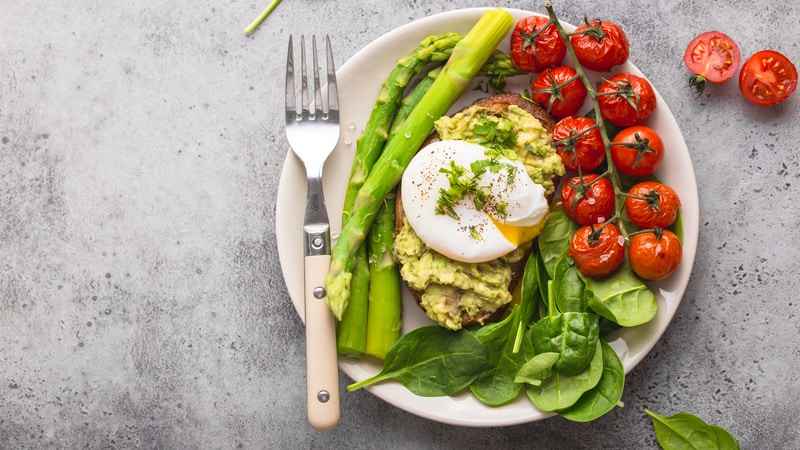Health: Make It Meatless!
How – and why – to incorporate more plants into your diet

If you’re motivated to make a healthy change this year, consider including meatless meals. There’s never been a better or more exciting time to give them a try. Not only will skipping meat — even just one meal or one day a week — benefit your health and the environment, making meatless meals that are nutritionally balanced, satisfying, and downright delicious is a snap once you learn the basics. Here’s what you need to know to chef up some meatless magic.
Healthy Habit
Replacing meat with plant-based foods is a positive move toward a healthier diet, even if it’s just one meal a week. Research shows that eating less meat, especially red and processed meat, and eating more plant-based foods, like vegetables, fruits, legumes, whole grains and nuts has many health benefits, including improving heart health, reducing risk of heart disease, Type 2 diabetes, and mortality. And it doesn’t take much. According to a study published last year in the journal BMJ, adding just a third of a cup more of fruit or vegetables to the diet each day could cut the risk of developing Type 2 diabetes by 25%, and increasing intake of whole grains, like whole wheat bread or oatmeal, could cut the risk by 29%.
A Plant-Based Diet Is Also Healthy for the Planet
Because producing plant foods tends to be less resource-intensive and environmentally destructive for many reasons, including lower levels of greenhouse gas emissions (GHGEs), compared to raising animals for human consumption (Nutrients, 2018). Research shows that livestock production, which requires more land, water, and energy, has the most significant impact on the environment.
Meatless 101
Make sure your meatless meal is nutritionally balanced, says Sharon Palmer, MSFS, RDN, The Plant-Powered Dietitian. “Sometimes plant-based meals can be low in protein. It’s important to get a serving of high-protein plant food — such as beans, lentils, peas, tofu, tempeh, seitan, or nuts like peanuts, almonds, and pistachios — on your meatless plate. Then it should be filled with veggies and a serving of whole grains,” says Palmer. When planning a meatless meal, it may help to think of it in the traditional style of serving a meat, vegetable, and starch. “In that way, you could do the same meal planning and simply swap the meat for something like simmered lentils or beans, a veggie burger patty, or a veggie loaf,” says Palmer.
No One Goes Hungry
A common misconception of meatless meals is that they leave you hungry. It’s important to get plenty of satisfying protein, fats, carbohydrates, and fiber on your meatless plate. It’s not enough to just put a bunch of vegetables on your plate, says Palmer. “You must have a serving of protein-rich plant foods, like tofu, seitan, pulses or meat alternatives, a serving of whole grains or starchy vegetables, like farro, brown rice or sweet potatoes, and a couple of vegetables,” she says. And include a source of healthy fats too, like vegetables or tofu roasted with extra virgin olive oil or adding avocado to your side-salad. This, Palmer says, “is a satisfying meal that will stick with you.”
Play Up Those Plants
One way to make meatless eating easy is to start with meatless versions of familiar meals; these could include tacos made with roasted vegetables, beans, rice and avocado, or spaghetti with meaty mushrooms. Another option, suggests Palmer, is to find a great recipe that just happens to be plant-based and delicious; for example, try black bean chili or squash stuffed with lentils and quinoa.
Meat alternatives are another way to go meatless. Although these products, like meatless sausage, ground beef, or chicken, can be a good, easy way for people to get introduced to a more plant-based diet, “the true beauty and health of a plant-based meal is eating more lentils, beans, peanuts, dried peas, tofu and tempeh — these are more whole and nutrient-rich,” says Palmer.
Give Meatless a Go
Start small — just one meal or one day a week. Plan a nutritionally balanced meal that has all the elements of a satisfying meal, but without the meat. Experiment with recipes, favorites and new, as you discover the healthy benefits of meatless meals.
And for even more wellness tips, visit our health page!
Reprinted with permission from Environmental Nutrition, a monthly publication of Belvoir Media Group, LLC. 800-829-5384. www.EnvironmentalNutrition.com.
©2021 Belvoir Media Group. Distributed by Tribune Content Agency, LLC.

